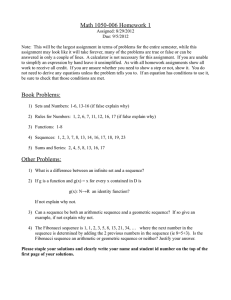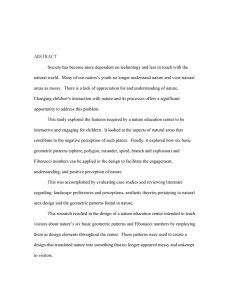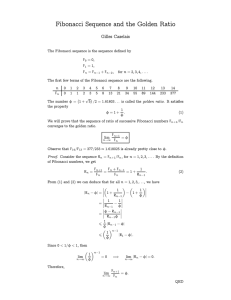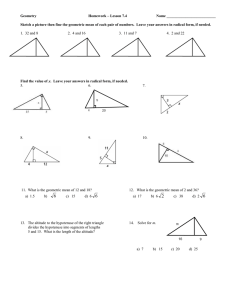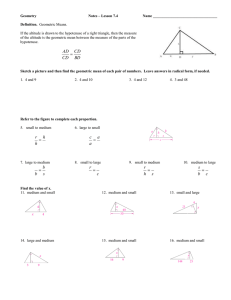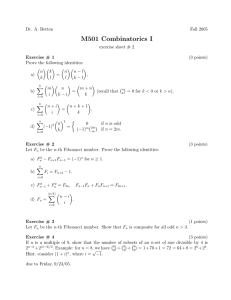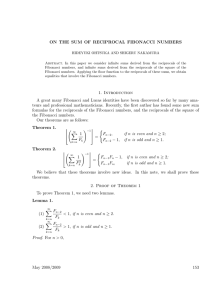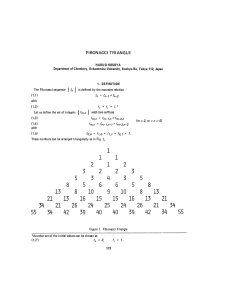Document 13570134
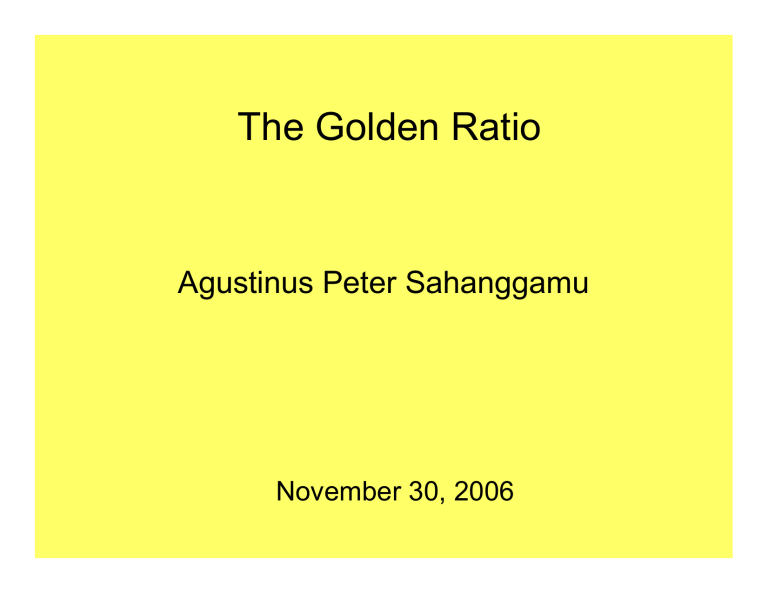
The Golden Ratio
Agustinus Peter Sahanggamu
November 30, 2006
Outline
¾ Geometric Definition
¾ Relation with Fibonacci Numbers
¾ Euclidean Geometric Construction
¾ Continuous Fraction Representation
Geometric Definition
(Mean and Extreme Ratio)
1
¾ x satisfies
1 − x 1 x 2 − x − 1 = 0
¾
¾
Golden ratio = positive root =
Negative root = 1 –
τ
=
μ
=
1 −
τ
√
2
=
5
1+
√
5
2
Relation with Fibonacci Numbers
¾ Binet’s Formula f n
= ( τ n − μ n ) /
√
5
¾ f n +1 f n
=
τ n +1 − μ n +1
τ n − μ n
¾ τ = lim n →∞ f n +1 f n since | τ / μ | > 1
Geometric Construction
¾ Construct a right triangle with sides
¾
1
2 and 1
¾
1 1
√
2 2
5
1
1
√
5
2
Continuous Fraction
Representation
¾
τ = 1 +
1 +
1
1
1+
1
1+ ···
1
¾ τ = lim u n
, where u n +1
= 1 + n →∞
¾ and u
1
= 1 u n
¾ Let u n
= a n +1
/a n with a
1
= a
2
= 1
¾ Recursion of a n is a n +2
= a n +1
+ a n
¾ { a n
} =
Fibonacci numbers
Infinite Resistor Network
¾ Each resistor has resistance 1 Ω
A
B
¾ Total resistance = r
= ?
¾ Recall a b
Total = a + b a b ab
Total = a + b
¾
Infinite Resistor Network
(continued)
1 r n +1
1 r n
1 r n +1
= 1 +
1 +
1 r n r = 1 +
1 +
1
1
1+
1
1+ ···
= τ
Exercise on Continued Fractions
( Young , Problem 9, page 156)
¾ Find p = 2 a + b
2 a + b
2 a + ··· with a, b positive integers
¾ p = lim p n with p
1
= 2 a and n →∞ p n +1
= 2 a + b p n
¾ Define p n
= u n +1
/u n
, u
1
= 1 , u
2
= 2 a
Exercise on Continued Fractions
(continued)
¾ u n +2
− 2 au n +1
− bu n
= 0
¾ Basis of solutions: u n
= λ n
¾ α =
¾ Note a
|
+
β |
λ 2
√
− a
< a
2
2
+
+
¾ General solution a u
λ
√ n
−
β
√ a 2 + b a 2 + b = α
= b
= c
= 0
α a n
−
+ d β n
¾ u n
=
α n − β n
(matching u
1 and u
2
)
α − β
Young , Problem 20, page 136
¾ For any four consecutive Fibonacci
¾ numbers f n − 1
, f n
, f n +1
, f n +2
¾ show that f n − 1 f n +2 and
2 f n f n +1
¾ form two shortest sides of a
¾ Pythagorean triangle.
¾ Write f n
= b and f n +1
= a, a > b
¾ x = a
¾ x 2 + y
2 a − b 2 b, b, a, a + b
2
−
= z
, y = 2 ab
2 , z = a 2 + b 2
Young , Problem 20, page 136
(continued)
¾ Hypotenuse z = f 2 n
+ f 2 n +1
¾ From previous class, f 2 n
+ f 2 n +1
= f
2 n +1
¾ How is the area related to the original
¾ four numbers?
¾ A = xy/ 2 = f n − 1 f n f n +1 f n +2
¾ Product of four consecutive Fibonacci
¾ numbers is the area of a Pythagorean
¾ triangle
